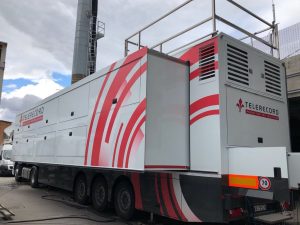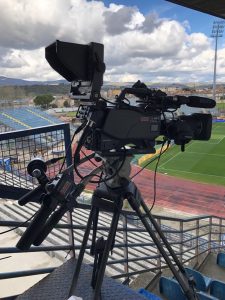Sky Italia and Telerecord undertake 4K HDR test at Serie B Empoli vs Venezia match

Telerecord on site at Stadio Carlo Castellani to capture the recent Empoli vs Venezia match in 4K HDR.
Earlier this season Sky Italia engaged Florentine production company Telerecord to capture an Italian Serie B match – specifically Empoli vs Venezia – in 4K HDR. The test – which was undertaken with a view to possible future broadcasts using these technologies – was broadcast on Sky Sports in HD, while those viewers with the latest SkyQ decoder were able to view it in 4K HDR.
Telerecord technical manager Giovanni Lorini told SVG Europe about the production workflows involved in the test: “Telerecord, in charge of the event, provided a double signal in HD and 4K HDR. The mobile vehicle sent to Empoli captured all the shots in 4K HDR, and from there the signals were sent via fiber optic distribution to Sky Santa Giulia broadcast centre in Milan for finalisation and airing.
“The replay equipment and video mixer worked with 4K and the output signal was converted into the one wanted by Sky, which is SLog3. This ‘HDR curve’ has been in use for several years for Sony cameras, cinema and high end productions.
“The workflow was completed by a video mixer in SLog3 with colour space Rec 2020 and from that format of ‘4K intermediate’, with appropriate converters, we could [derive] all the useful formats, such as 4K HLG (Hyper Log Gamma), HD SDR or others.”
All the cameras used were Sony HDC4300s with 2/3” sensors, while the team used Fujinon 4K TV optics with high-performance zoom capabilities that even reached 100X. Sony’s RVS8000x video mixer was another core component of the production workflow.
Cameras and graphics
In terms of the camera configuration, said Lorini, “the shooting layout followed the standard of the Series B with 5 cameras, with the main camera in the centre of the tribune, next to camera 2 that took care of the narrow shots and close-ups. Camera 3 was placed at the centre-field on a mobile support called ‘piattina’ that moves together with the camera; and cameras 4 and 5 were placed in the stands [and dealt] mainly with the ‘out of game’. All cameras were placed on the same side and all signals travelled via fiber optic.
“Another aspect not common for this type of television production is that all the replay channels were in 4K native – for all 5 cameras and for the clean feed from which the highlights of the game were produced, so [a total of] 24 recording channels were engaged.
“Telerecord on the spot decided to use mobile unit 26, a 16-metre poised trailer that fully expanded us six metres wide. The staff employed consisted of five operators for the cameras, a sound engineer, three replay operators, two camera controllers, a technical manager and two audio assistants.
“The graphic customisation was realised with the same production cameras, in position 3, and the local graphics were realised in 1080p.”
Format conversion

Sony HDC4300s with 2/3” sensors were used to capture the action for the 4K HDR test.
The few problems that emerged were related to the presence of content not yet native to 4K HDR, such as graphics, which must be processed before use. “For this test a high-performance Sony converter, HDRC4000, was used at the output, operating four simultaneous conversions. From the incoming 4K Slog3 double feed we could down-convert the HD signals and other useful 4K formats. From the point of view of audio-visual language, the 4K 50p offers a lot of resolution in every frame and does not require [a great deal of attention] to focus.
“Another specific problem concerns the simultaneous presence in production of 4K HDR and HD signals, [meaning that] the same exposure latitude cannot be used. This implies an obligatory choice in favouring high lights or low lights.”
Lorini concluded by outlining the monitoring and audio set-ups for this test: “The entire monitoring was in HD for the control rooms, while the reference monitor in 4K was the Sony X300 (certified by Amazon and Netflix for production in 4K) that [offers] excellent brightness and a very real contrast ratio between white and black. [Meanwhile] for the audio, there were six microphones positioned at the corners, at 16 metres.”
